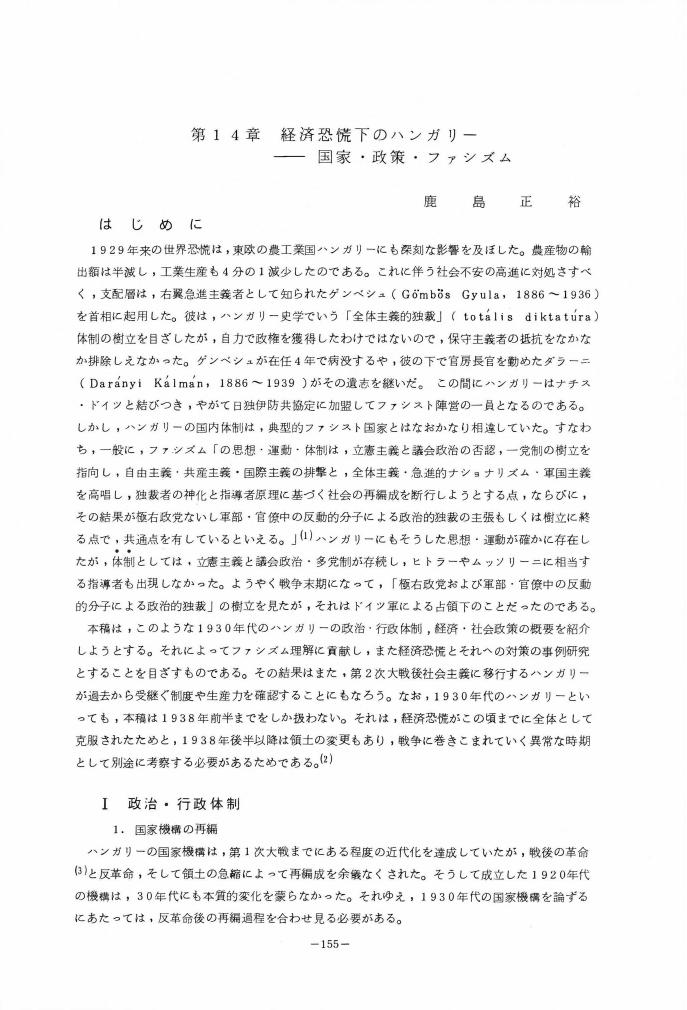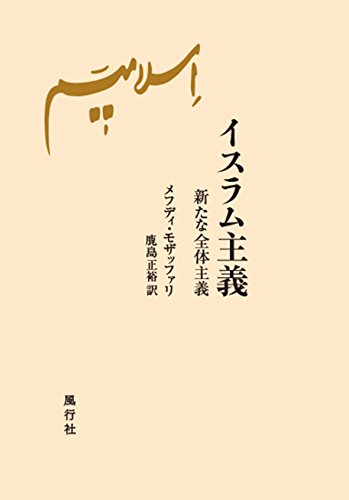5 0 0 0 OA 「民主化の波」の成功と失敗──東欧諸国とアラブ諸国の比較試論
- 著者
- 鹿島 正裕 Masahiro Kashima
- 雑誌
- 放送大学研究年報 = Journal of The Open University of Japan (ISSN:09114505)
- 巻号頁・発行日
- vol.33, pp.125-139, 2016-03-25
3 0 0 0 IR ハンガリーの改革の意味するもの--社会主義の歴史的理解のために
- 著者
- 鹿島 正裕
- 出版者
- アジア経済研究所
- 雑誌
- アジア経済 (ISSN:00022942)
- 巻号頁・発行日
- vol.15, no.5, pp.52-66, 1974-05
1 0 0 0 OA 第14章 経済恐慌下のハンガリー―国家・政策・ファシズム―
- 著者
- 鹿島 正裕
- 出版者
- 東欧史研究会
- 雑誌
- 東欧史研究 (ISSN:03866904)
- 巻号頁・発行日
- vol.1, pp.155-175, 1978 (Released:2017-09-28)
1 0 0 0 OA 1919年のハンガリー社会主義 : 評議会国家とその国内政策
- 著者
- 鹿島 正裕
- 出版者
- アジア経済研究所
- 雑誌
- アジア経済 (ISSN:00022942)
- 巻号頁・発行日
- vol.18, no.8, pp.30-46, 1977-08-01
金沢大学人間社会研究域法学系
1 0 0 0 OA スエズ戦争(1956年)と米国・エジプト関係
- 著者
- 鹿島 正裕
- 出版者
- 金沢大学法学部 = The Faculty of Law, University of Kanazawa
- 雑誌
- 金沢法学 = Kanazawa law review (ISSN:0451324X)
- 巻号頁・発行日
- vol.37, no.1, pp.37-68, 1995-01-27
1 0 0 0 イスラム主義 : 新たな全体主義
- 著者
- メフディ・モザッファリ著 鹿島正裕訳
- 出版者
- 風行社
- 巻号頁・発行日
- 2018
1 0 0 0 OA 中東における地域政治の構造と展開-理論的分析の成果と課題-
- 著者
- 鹿島 正裕
- 出版者
- JAPAN ASSOCIATION OF INTERNATIONAL RELATIONS
- 雑誌
- 国際政治 (ISSN:04542215)
- 巻号頁・発行日
- vol.2005, no.141, pp.132-148,L15, 2005-05-29 (Released:2010-09-01)
- 参考文献数
- 16
To be sure, there has been a rather impressive accumulation of research into the regional politics of the Middle East, centering on the Arab-Israeli conflicts, Gulf wars and the involvement of the super-powers therein. However, most of the monographs are more “descriptive” than “theoretical-analytical, ” whether they are historical studies or report on current affairs. While it is perhaps not an exaggeration to claim that most of the related works in Arabic and Japanese are such, some among those in English are theoretical-analytical works, reflecting the heightened demand, especially in the United States, for more social scientific approaches within area studies.A typical work in this genre is Steven Walt's The Origins of Alliances (1987), which may be said to have used area studies to establish a social scientific theory, rather than introduced social scientific approaches to area studies. Works that are more based on area studies include Michael Barnette's Dialogues in Arab Politics (1998) and Raymond Hinnebusch's The International Politics of the Middle East (2003). Barnette's work discusses the politics among Arab states, the core of the Middle East states, as does Avraham Sela's The Decline of the Arab-Israeli Conflict published in the same year, although not particularly in a theoretical-analytical way. Both works should be considered as studies in the regional politics of the Middle East, as the conflict with Israel has been strongly tied with the various rivalries among Arab states. Walt's and Hinnebusch's works discuss the regional politics in the Middle East, which involve, in addition to Arab states and Israel, Iran and the great powers.In terms of their theoretical tenets, Walt's and Sela's are (neo-) realist and Barnette's constructivist, while Hinnebusch's is liberal, incorporating not only realist frameworks but also constructivist and pluralist (liberal-institutionalist) concepts and even (neo-Marxist) structuralist perspectives. I describe these basic theoretical arguments and delineations of historical phases found in each work, finding Hinnebusch's argument most comprehensive and persuasive.Moreover, I look at some other books and articles, among which is Paul Noble's “Systemic Approaches Do Matter, But…” (2004) In this article, Noble tries to apply systemic approaches to the study of the Middle East system and offers a set of regional and sub-regional systemic factors in addition to global systemic factors as explanatory variables. I take up his argument of the global systemic factor change in the post-Cold War period and raise some issues to be explored concerning this on-going period, such as democratization, privatization, and regionalization in Muslim and “rentier” states of the region, especially after the Iraq War (2003).
1 0 0 0 OA 第三次中東戦争に至る政治過程と米国の「関与」
- 著者
- 鹿島 正裕
- 出版者
- JAPAN ASSOCIATION OF INTERNATIONAL RELATIONS
- 雑誌
- 国際政治 (ISSN:04542215)
- 巻号頁・発行日
- vol.1996, no.113, pp.135-151,L15, 1996-12-30 (Released:2010-09-01)
- 参考文献数
- 56
The third Arab-Israeli war of 1967 quickly ended in an overwhelming victory for Israel, in what is called the “Six-day war” by her. At that time, the Arab countries claimed that the United States had participated in the war on the Israeli side, and severed diplomatic relationship with her. Because the U. S. -Egyptian relationship had already been bad before the war, and the Israeli aerial attack was far more efficient than Egyptians had expected, they suspected U. S. -Israeli complicity. In fact, the Johnson administration had repeatedly warned Israel not to initiate hostility, while trying to organize an international fleet to deter Egypt from the use of force. The Arab side, however, continued to maintain that the United States had encouraged Israel to attack Egypt in order to weaken the revolutionary Nasser regime. The then unofficial spokesman of Nasser, Mohamed Heikal, still does so in his recent thick book “1967 al-Infijal (outbreak)” (Cairo, 1990), which is based on declassified documents of the United States and Egypt.According to him, when Egypt demanded the United Nations Emergency Force (which had been stationed in Sinai Peninsular since the 1956 Suez War) to leave from the Israeli border area, United Nations Under-Secretary Ralph Bunche, an American, advised Secretary-General U Thant not to accept partial withdrawal, thus provoking Egypt to demand total withdrawal and to occupy Sharm el-Sheikh and then close the Strait of Tiran for Israel. It was an American plot to give Israel a casus belli. After that the United States warned Egypt, in cooperation with the Soviet Union, not to initiate hostility while hinting to Israel that she would not, unlike on the occasion of the Suez War, support any United Nations move to sanction Israel if she attacked Egypt.On the American side, serious studies based on declassified documents as well as interviews with then policy-makers have been accumulated, some of which expressly try to refute the Egyptian accusations. I have studied and compared these books and articles, checked many of the documents and interviewed some people myself, and concluded that it is not that the United States “unleashed” Israel to attack Egypt, but that the Nasser regime itself let, through a series of miscalculations, the Egyptian military provoke Israel into war. However, Israeli decision-makers were wise enough not to attack Arab forces prematurely—they gave time to the U. S. and Britain to try to organize the international fleet. When the Johnson administration found the efforts rather fruitless, it was in fact inclined to let Israel help herself. In this sense the United States was involved in the political process leading to the outbreak of the war.
1 0 0 0 OA 「民主化の波」の成功と失敗──東欧諸国とアラブ諸国の比較試論
- 著者
- 鹿島 正裕 Masahiro Kashima
- 雑誌
- 放送大学研究年報 = Journal of The Open University of Japan (ISSN:09114505)
- 巻号頁・発行日
- vol.33, pp.125-139, 2016-03-25
1989年に東欧で起こった民主化の波は、ほとんどの諸国を平和裏に自由民主主義国へと導いたが、2011年に一部のアラブ諸国で起き始めた民主化の波は、4国で独裁政権の崩壊をもたらしたものの、多くのアラブ諸国においては政権の若干の譲歩か弾圧によって抑え込まれるか、内戦をもたらしてしまった。民主化し始めた4国でも、チュニジア以外では権威主義政権の復活や内戦に至り、今のところ失敗に終わっている。この両地域の顕著な相違を説明するために、民主化に関する近年の理論的研究を参照して比較の枠組みを設定したうえで、両地域の①民主化前の状況、②\n民主化の波、③その後の展開を概観する。そして統計的データも参照し、(1)国家のあり方──政治秩序の類型、政府の機能、民主的価値観の普及度、エリート層や軍部の内情、(2)社会のあり方──所得向上と中間層の増大、市民社会化、宗教的寛容度、ジェンダー間の平等度、天然資源への依存度、青年層の不満度、(3)外国の影響──大国の関与、近隣諸国の民主化、コミュニケーション手段の発達、の諸要因を比較する。東欧諸国の成功とアラブ諸国の失敗はそれらによってよく説明され、アラブ諸国の今後の民主化可能性にも示唆を得られる。
- 著者
- 鹿島 正裕
- 出版者
- 金沢大学法学部 = The Faculty of Law, University of Kanazawa
- 雑誌
- 金沢法学 (ISSN:0451324X)
- 巻号頁・発行日
- vol.30, no.1, pp.p31-62, 1987-12
1 0 0 0 IR 植民地支配の政治経済学--イギリスのエジプト統治,1882-1914年
- 著者
- 鹿島 正裕
- 出版者
- 金沢大学法学部 = The Faculty of Law, University of Kanazawa
- 雑誌
- 金沢法学 (ISSN:0451324X)
- 巻号頁・発行日
- vol.29, no.1, pp.p165-208, 1987-03
- 著者
- 鹿島 正裕
- 出版者
- 金沢大学法学部 = The Faculty of Law, University of Kanazawa
- 雑誌
- 金沢法学 = Kanazawa law review (ISSN:0451324X)
- 巻号頁・発行日
- vol.30, no.1, pp.31-62, 1987-12-25
1 0 0 0 OA 植民地支配の政治経済学 : イギリスのエジプト統治, 1882-1914年
- 著者
- 鹿島 正裕
- 出版者
- 金沢大学法学部 = The Faculty of Law, University of Kanazawa
- 雑誌
- 金沢法学 = Kanazawa law review (ISSN:0451324X)
- 巻号頁・発行日
- vol.29, no.1・2, pp.165-208, 1987-03-25

